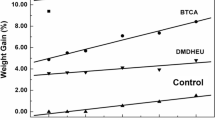Abstract
In this study, the surface layer of cotton fabric was swelled with N-methylmorpholine-N-oxide with 18 % water content, washed and dried to improve its stiffness property. Finally, the finished fabric had no auxiliaries and self-stiffened. The results showed that the bending rigidity increased from 0.75 × 105 to 1.57 × 105 mN cm, the acute elastic crease recovery angle from 95.2° to 117.3°, the delayed elastic crease recovery angle from 117.6° to 146.6° and the moisture regain from 8.07 to 10.3 %. The stiffness was almost unaffected by 30 multiple washing times. The tear strength, breaking strength and whiteness properties remained excellent. Scanning electron microscopy showed that the edges of finished fibres obviously curled. According to infrared spectrum analysis, no new groups were found. X-ray diffraction analysis showed that the crystal structure of the fibre changed, with cellulose II formed disorderly in the surface layer of the cotton fibres. This mechanism permits the cotton fabric to self-stiffen in the modifying process.







Similar content being viewed by others
References
Cheng CZ, Xu JG, Luo Q, Sun YS, Xu MF (2012) Swelling and dissolution of cellulose in solution of NMMO/H2O. Synth Fibre China 41(7):15–19
Cuissinat C, Navard P (2006) Swelling and dissolution of cellulose part 1: free floating cotton and wood fibres in N-methylmorpholine-N-oxide-water mixtures. Macromol Symp 244:1–18
Duan XF, Wang SX, Wu WQ (2006) Synthesis of ultra-low form aldehyde hard resins WD-2. Hebei Chem Ind 29(10):30–32
He WD, Yang XB, Xiang DX, Zhang WL (2011) Low formaldehyde stiffening agent. Dyeing Finish J 15:34–35
Hu XL, Wang CM (2008) Synthesis of stiffening agent and its property. Dyeing Finish J 10:13–15
Khoddami A, Shokohi SS, Morshed M, Abedi D (2011) Simultaneous application of silver nanoparticles with different crease resistant finishes. Fibers Polym 12(05):635–641
Lai YB, Long S, Yuan W, Song SH, Guo J (2012) Study on the application of low formaldehyde stiffening agent in fabric finishing. Text Aux 29(9):46–48
Li L, Sheng GZ (2009) Analysis on crystalline structure of cellulose fibre from cotton-straw bast by X-ray diffraction method. J Cellul Sci Technol 17(04):37–41
Li J, Lin LN, Yan W, Cai YJ, Zeng QF (2011) Swelling and dissolution of ramie fibers in N-methylmorpholine N-oxide solution. Text Aux 28(6):15–17
Liu JM, Wang JK, Xu MM (2013) Effect of sizing cotton polyester blended yarn by phosphate grafted starch. Cotton Text Technol 41(3):22–24
Luo JT, Chen LL, Xu WQ (2008) Analysis of problems arising in stiffing finish with melamine resin. Dyeing Finish J 07:31–33
Rosenau T, Potthast A, Sixta H, Kosma P (2001) The chemistry of side reactions and byproduct formation in the system NMMO/cellulose (Lyocell process). Prog Polym Sci 26:1763–1837
Teli MD, Sheikh J, Bhavsar P (2013) Multifunctional finishing of cotton using chitosan extracted from bio-waste. Int J Biol Macromol 54:125–130
Wang T, Guan LY (1997) The research of environmental stiffing agent GW-308. Text Aux 14(6):27–29
Wang HY, Li D (2011) Pad-steam anti-crease finish of cotton fabric. J Text Res 32(05):91–95
Wu BH, Lv QY (2010) The effect of crease-resistant finish on the cotton fibre structure. Prog Text Sci Technol 03:22–23
Xiao CF (1994) Study on dissolution mechanism of cellulose in N-methymorpholine oxide/dimethylsulfoxide. J Cellul Sci Technol 2(3-4):66–71
Xu W, An QF, Hao LF, Sun Z, Zhao WJ (2013) Synthesis of cationic core-shell fluorine-containing polyacrylate soap-free latex and its application on cotton substrate. Fibers Polym 14(6):895–903
Zhai BJ, Zhang RJ (2008) Multi-functional finish of cotton fabric. Dyeing Finish J 09:11–13
Zhang HZ, Liu BL, Luo R (2005) Recent advances in the biodegradability of PVA and its derivative material. J Grad Sch Chin Acad Sci 22(06):657–666
Zhang C, Yu SM, Gao XL (2007) Research progress of green textile size at home and abroad. Prog Text Sci Technol 06:15–16
Zhang K, Fu SH, Tian AL, Wang CX, Zhang X (2012) Dispersion stability of water soluble ultrafine carbon black in N-methylmorpholine-N-oxide solution. J Text Res 33(1):65–69
Zhou XD, Jiang M, Yi H, Zhang TY (2009) Synthesis of environmental friendly stiffener and its application in textiles. Text Aux 26(10):30–34
Acknowledgments
This work was supported by the Fundamental Research Funds for the Central Universities (Grant No. XDJK2013A021).
Author information
Authors and Affiliations
Corresponding author
Rights and permissions
About this article
Cite this article
Xu, F., Yang, Y., Zhang, G. et al. A self-stiffness finishing for cotton fabric with N-methylmorpholine-N-oxide. Cellulose 22, 2837–2844 (2015). https://doi.org/10.1007/s10570-015-0686-z
Received:
Accepted:
Published:
Issue Date:
DOI: https://doi.org/10.1007/s10570-015-0686-z



